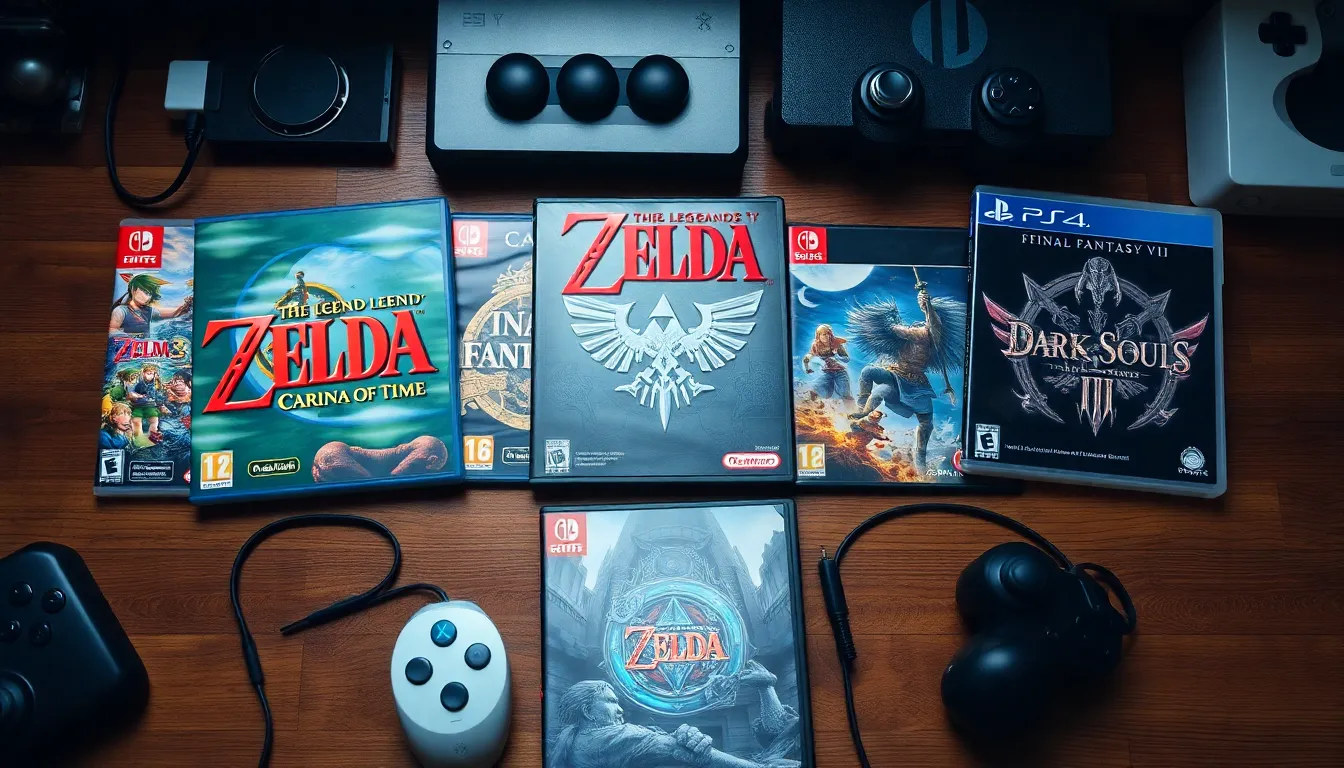In a world where gaming has become a dominant form of entertainment, video game critiques play a vital role in shaping player experiences. These assessments not only influence purchasing decisions but also impact the industry by holding developers accountable for their creations. As players seek more than just entertainment, they crave insights that elevate their understanding of the games they love.
Critiques delve into various aspects of gaming, from storytelling and graphics to mechanics and user experience. They help players navigate an ever-expanding landscape of titles, ensuring that the most engaging and innovative games rise to the top. By examining the nuances of game design, critiques foster a deeper appreciation for the artistry behind the pixels, making them essential for both gamers and developers alike.
Table of Contents
ToggleOverview of Video Game Critiques
Video game critiques analyze games through various aspects that significantly impact player engagement. These critiques evaluate storytelling, graphics, gameplay mechanics, sound design, and user experience. By examining these components, critiques offer insights that assist players in making informed decisions.
Critiques often identify strengths and weaknesses within a game. Strong storytelling enhances emotional connections, while immersive graphics elevate the overall experience. Effective gameplay mechanics contribute to enjoyable interactions, and high-quality sound design adds depth. User experience plays a pivotal role in accessibility and navigation, ensuring players can fully engage with the game.
Different formats exist for presenting critiques, including written reviews, video analyses, and podcasts. Each format caters to varied preferences, allowing audiences to consume content in their preferred way. Aggregation sites compile scores and reviews, giving a broader perspective on a game’s reception.
Critiques also serve as a feedback mechanism for developers. Constructive criticism can inspire improvements to future releases, foster innovation, and encourage developers to uphold quality standards. This dynamic underscores the importance of critiques in the evolution of the gaming industry, allowing for informed conversations between players and creators.
Historical Context

Video game critiques have undergone significant changes since the inception of the gaming industry. Understanding their evolution highlights their crucial role in shaping player experiences and influencing game development.
Evolution of Game Reviews
Game reviews emerged in the late 1970s and early 1980s, coinciding with the rise of arcade games and home consoles. Initially, reviews appeared in magazines, with publications like Electronic Gaming Monthly providing print critiques. The shift to online platforms in the late 1990s expanded access, enabling publications like IGN and GameSpot to reach wider audiences. As technology evolved, so did review formats, incorporating video reviews and streams to engage viewers. Today, user-generated content on platforms like YouTube and Twitch complements traditional critiques, reflecting diverse opinions and fostering community discussions.
Influential Critiques
Several critiques have significantly impacted the gaming landscape. The Legend of Zelda: Ocarina of Time (1998) received praise for its groundbreaking design, influencing future action-adventure titles. Reviews of Final Fantasy VII (1997) highlighted the emotional depth of storytelling, helping popularize character-driven narratives in RPGs. The Dark Souls series sparked discussions on difficulty and game design, illustrating the importance of challenge in player engagement. Each influential critique not only showcased the potential of video games as an art form but also set benchmarks for design and storytelling, shaping the expectations of players and developers alike.
Criteria for Evaluation
Evaluating video games requires a detailed analysis of several core elements. These criteria help determine a game’s overall quality and impact on players.
Gameplay Mechanics
Gameplay mechanics refer to the rules and systems that dictate player interactions within a game. These include controls, difficulty, balance, and the overall flow of gameplay. A well-designed gameplay experience offers intuitive controls, allowing players to engage seamlessly with the game. Balanced difficulty ensures a challenging yet fair experience, promoting player satisfaction. Additionally, innovative mechanics can set a game apart, fostering uniqueness and interest in the gameplay experience.
Graphics and Design
Graphics and design encompass a game’s visual aspects, including art style, animation quality, and environmental design. High-quality graphics can enhance immersion, drawing players into the game world. A distinct art style contributes to a game’s identity, making it memorable. Effective environmental design provides players with clear navigation cues and enhances storytelling through visual cues. Cohesive graphics and design elements elevate the player’s overall experience, making visual quality a vital evaluation criterion.
Storytelling and Narrative
Storytelling and narrative explore the plot, character development, and emotional engagement within a game. Strong narratives captivate players, creating lasting emotional connections with characters and themes. Compelling character arcs and well-developed backgrounds enrich the gameplay experience, encouraging players to invest in the game’s story. A well-paced narrative enhances engagement, guiding players through arcs that evoke curiosity and encourage exploration. Evaluating storytelling quality helps clarify how effectively a game communicates its themes and engages its audience.
The Role of Critics
Critics play a vital role in the gaming industry, shaping perceptions and experiences across the gaming community. They analyze numerous elements, providing essential insights that influence both players and developers.
Impact on the Gaming Industry
Critics significantly affect the gaming industry by informing trends and setting standards. Their evaluations can highlight innovative design and gameplay mechanics, which prompts developers to push creative boundaries. Reviews often trigger discussions that lead to industry-wide changes, encouraging improvement in game quality and player satisfaction. Historical critiques, such as those for The Legend of Zelda: Ocarina of Time and Dark Souls, set benchmarks for excellence that developers strive to meet, showcasing the powerful influence of critical feedback on game development.
Influence on Consumer Choices
Critics shape consumer choices through their analyses and ratings. High scores and positive reviews can lead to increased sales, while negative critiques often deter potential buyers. Players frequently rely on critics to navigate vast game libraries, making purchasing decisions much smoother. Thus, critics serve as trusted sources, guiding gamers toward titles that offer enriching experiences. In this way, critiques bridge the gap between consumer expectations and developer offerings, ensuring that players engage with quality content.
Emerging Trends in Video Game Critiques
Emerging trends in video game critiques reflect the dynamic nature of both gaming and audience expectations. Two notable shifts involve user-generated reviews and the incorporation of player feedback.
User-generated Reviews
User-generated reviews increasingly influence public perception of video games. Players often share experiences on platforms like Metacritic, Steam, and Reddit, providing a multitude of perspectives on various titles. These reviews offer raw, unfiltered opinions, showcasing diverse viewpoints that official critiques may overlook. Factors such as personal engagement and unique interpretations enrich the discussion around game quality and gameplay experiences. This shift towards user-generated content helps democratize game critiques, allowing a broader spectrum of voices to shape the discourse.
Incorporating Player Feedback
Incorporating player feedback into game critiques is a growing trend. Critics now often reference community responses, considering player experiences during their analyses. This approach enhances the relevance of critiques, as it aligns evaluations with the players’ sentiments. Many developers actively seek player opinions through forums, surveys, and social media, using this information to refine or expand their game offerings. Additionally, some critiques involve live discussions and interactive formats, where player perspectives shape ongoing dialogue about game quality and features. This collaborative landscape emphasizes the importance of player involvement in critiquing and developing video games.
Video game critiques serve as a vital bridge between players and developers. They not only enhance player experiences but also drive innovation within the industry. As critiques evolve alongside gaming trends, they reflect the diverse voices of the community and shape the future of game design. This ongoing dialogue fosters a more informed and engaged gaming culture, ensuring that both players and creators benefit from the insights shared. By valuing critiques, the industry can continue to thrive and push creative boundaries, ultimately enriching the world of gaming.




